Effect of Temperature on Space Charge Distribution of Oil–Paper Insulation under DC and Polarity Reversal Voltage
Abstract
:1. Introduction
2. Experimental Method
2.1. Sample Preparation
2.2. Test System
3. Test Results
3.1. Space Charge Distribution under DC Electric Field
3.2. Space Charge Distribution During Short-Circuit
3.3. Space Charge Distribution under Polarity Reversal Voltage
3.4. Electric Field Distribution under Polarity Reversal Voltage
4. Analysis and Discussion
4.1. Effect of Temperature on the Generation and Migration of Charge
4.2. Effects of Temperature on Space Charge During a Short-Circuit
4.3. Effects of Temperature on Distribution of Space Charge and Electric Field under Polarity Reversal Voltage
5. Conclusions
- The space charge accumulated inside the oil-impregnated pressboard is not clear at −20 °C; homocharge and heterocharge both increase with an increase in temperature, but heterocharge only accumulates at high temperatures. Therefore, the space charge within the pressboard first increases, then decreases, with the increase in temperature.
- The decay rate of space charge increases with an increase in temperature. Moreover, space charge decays rarely during voltage polarity reversal, leading to a serious distortion of the electric field distribution at the interface.
- The electric field at the interface is affected not only by the charge density but also by the charge distribution. The electric field at the interface at 40 °C is largest after the voltage polarity is reversed, while the electric field inside the sample at 60 °C is largest under DC voltage.
- Compared to thin oil-impregnated paper (thickness less than 500 μm), the space charge inside thick oil-impregnated pressboard takes a long time to reach stability, and it decays slowly during a short-circuit test.
Author Contributions
Funding
Conflicts of Interest
References
- Amoiralis, E.I.; Tsili, M.A.; Kladas, A.G. Power transformer economic evaluation in decentralized electricity markets. IEEE Trans. Ind. Electron. 2012, 59, 2329–2341. [Google Scholar] [CrossRef]
- Chen, Q.; Zhang, J.; Chi, M.; Guo, C. Breakdown Characteristics of Oil-Pressboard Insulation under AC-DC Combined Voltage and Its Mathematical Model. Energies 2018, 11, 1319. [Google Scholar] [CrossRef]
- Montanari, G.C. Binging an insulation to failure: E role of space charge. IEEE Trans. Dielectr. Electr. Insul. 2011, 18, 339–364. [Google Scholar] [CrossRef]
- Mazzanti, G.; Montanari, G.C.; Dissado, L.A. Electrical aging and life models: The role of space charge. IEEE Trans. Dielectr. Electr. Insul. 2005, 12, 876–890. [Google Scholar] [CrossRef]
- Lundgaard, L.E.; Hansen, W.; Linhjell, D.; Painter, T.J. Aging of oil-impregnated paper in power transformers. IEEE Trans. Power Deliv. 2004, 19, 230–239. [Google Scholar] [CrossRef]
- Hao, J.; Zhou, R.; Liao, R.; Yang, L.; Liao, Q. New Method for Shallow and Deep Trap Distribution Analysis in Oil Impregnated Insulation Paper Based on the Space Charge Detrapping. Energies 2018, 11, 271. [Google Scholar] [CrossRef]
- Zhou, Y.X.; Huang, M.; Chen, W.J.; Jin, F.B. Space charge behavior of oil-paper insulation thermally aged under different temperatures and moistures. J. Electr. Eng. Technol. 2015, 10, 1129–1135. [Google Scholar] [CrossRef]
- Hao, J.; Chen, G.; Liao, R.; Yang, L.; Tang, C. Influence of Moisture on Space Charge Dynamics in Multilayer Oil-Paper Insulation. IEEE Trans. Dielectr. Electr. Insul. 2012, 19, 1456–1464. [Google Scholar] [CrossRef]
- Tang, C.; Chen, G.; Fu, M.; Liao, R.J. Space Charge Behavior in Multi-layer Oil-paper Insulation under Different DC Voltages and Temperatures. IEEE Trans. Dielectr. Electr. Insul. 2010, 17, 775–784. [Google Scholar] [CrossRef]
- Zhu, Q.; Wang, X.; Wu, K.; Cheng, Y.; Lv, Z.; Wang, H. Space charge distribution in oil impregnated papers under temperature gradient. IEEE Trans. Dielectr. Electr. Insul. 2015, 22, 142–151. [Google Scholar] [CrossRef]
- Wu, K.; Zhu, Q.; Chen, X.; Wang, X.; Cheng, Y. Effect of temperature gradient on space charge distribution in oil impregnated papers. High Volt. Eng. 2011, 37, 671–675. [Google Scholar] [CrossRef]
- Wang, S.; Zhang, G.; Mu, H.; Wang, D.; Lei, M.; Suwarno, S.; Tanaka, Y.; Takada, T. Effects of paper-aged state on space charge characteristics in oil-impregnated paper insulation. IEEE Trans. Dielectr. Electr. Insul. 2012, 19, 1871–1878. [Google Scholar] [CrossRef]
- Huang, M.; Zhou, Y.; Dai, C.; Chen, W.; Lu, L.; Sha, Y. Charge Transport in thermally and Electrically Stressed Oil-impregnated Paper Insulation. IEEE Trans. Dielectr. Electr. Insul. 2016, 23, 266–274. [Google Scholar] [CrossRef]
- Huang, M.; Zhou, Y.; Chen, W.; Lu, L.; Jin, F.; Huang, J. Space Charge Behavior Evolution with Thermal Aging of Oil-paper Insulation. IEEE Trans. Dielectr. Electr. Insul. 2015, 22, 1381–1388. [Google Scholar] [CrossRef]
- Huang, B.; Hao, M.; Hao, J.; Fu, J.; Wang, Q.; Chen, G. Space charge characteristics in oil and oil-impregnated pressboard and electric field distortion after polarity reversal. IEEE Trans. Dielectr. Electr. Insul. 2016, 23, 881–891. [Google Scholar] [CrossRef]
- Huang, M.; Zhou, Y.; Chen, W.; Sha, Y.; Jin, F. Influence of voltage reversal on space charge behavior in oil-paper insulation. IEEE Trans. Dielectr. Electr. Insul. 2014, 21, 331–339. [Google Scholar] [CrossRef]
- Huang, M.; Zhou, Y.; Chen, W.; Lu, L.; Jin, F.; Huang, J. Space charge dynamics at the physical interface in oil-paper insulation under DC voltage. IEEE Trans. Dielectr. Electr. Insul. 2015, 22, 1739–1746. [Google Scholar] [CrossRef]
- Chong, Y.L.; Chen, G.; Ho, Y.F. Temperature effect on space charge dynamics in XLPE insulation. IEEE Trans. Dielectr. Electr. Insul. 2007, 14, 65–76. [Google Scholar] [CrossRef] [Green Version]
- Fu, M.; Dissado, L.A.; Chen, G.; Fothergill, J.C. Space charge formation and its modified electric field under applied voltage reversal and temperature gradient in XLPE cable. IEEE Trans. Dielectr. Electr. Insul. 2008, 15, 851–860. [Google Scholar] [CrossRef] [Green Version]
- Gallot-Lavallée, O.; Teyssèdre, G.; Laurent, C.; Rowe, S. Space charge behaviour in an epoxy resin: The influence of fillers, temperature and electrode material. J. Phys. D Appl. Phys. 2005, 38, 2017–2025. [Google Scholar] [CrossRef]
- Hussin, N.; Chen, G. Analysis of space charge formation in LDPE in the presence of crosslinking byproducts. IEEE Trans. Dielectr. Electr. Insul. 2012, 19, 126–133. [Google Scholar] [CrossRef] [Green Version]
- Takada, T.; Sakai, T. Measurement of electric-fields at a dielectric electrode interface using an acoustic transducer technique. IEEE Trans. Dielectr. Electr. Insul. 1983, 18, 619–628. [Google Scholar] [CrossRef]
- Morshuis, P.; Jeroense, M. Space charge measurements on impregnated paper: A review of the PEA method and a discussion of results. IEEE Electr. Insul. Mag. 1997, 13, 26–35. [Google Scholar] [CrossRef]
- Hao, M.; Zhou, Y.; Chen, G.; Wilson, G.; Jarman, P. Space charge behaviour in thick oil-impregnated pressboard under HVDC stresses. IEEE Trans. Dielectr. Electr. Insul. 2015, 22, 72–80. [Google Scholar] [CrossRef]
- Tanaka, Y.; Hanawa, K.; Suzuki, K.; Takada, T. Attenuation recovery technique for acoustic wave propagation in PEA method. In Proceedings of the 2001 International Symposium on Electrical Insulating Materials (ISEIM 2001), Himeji, Japan, 22–22 November 2001. [Google Scholar]
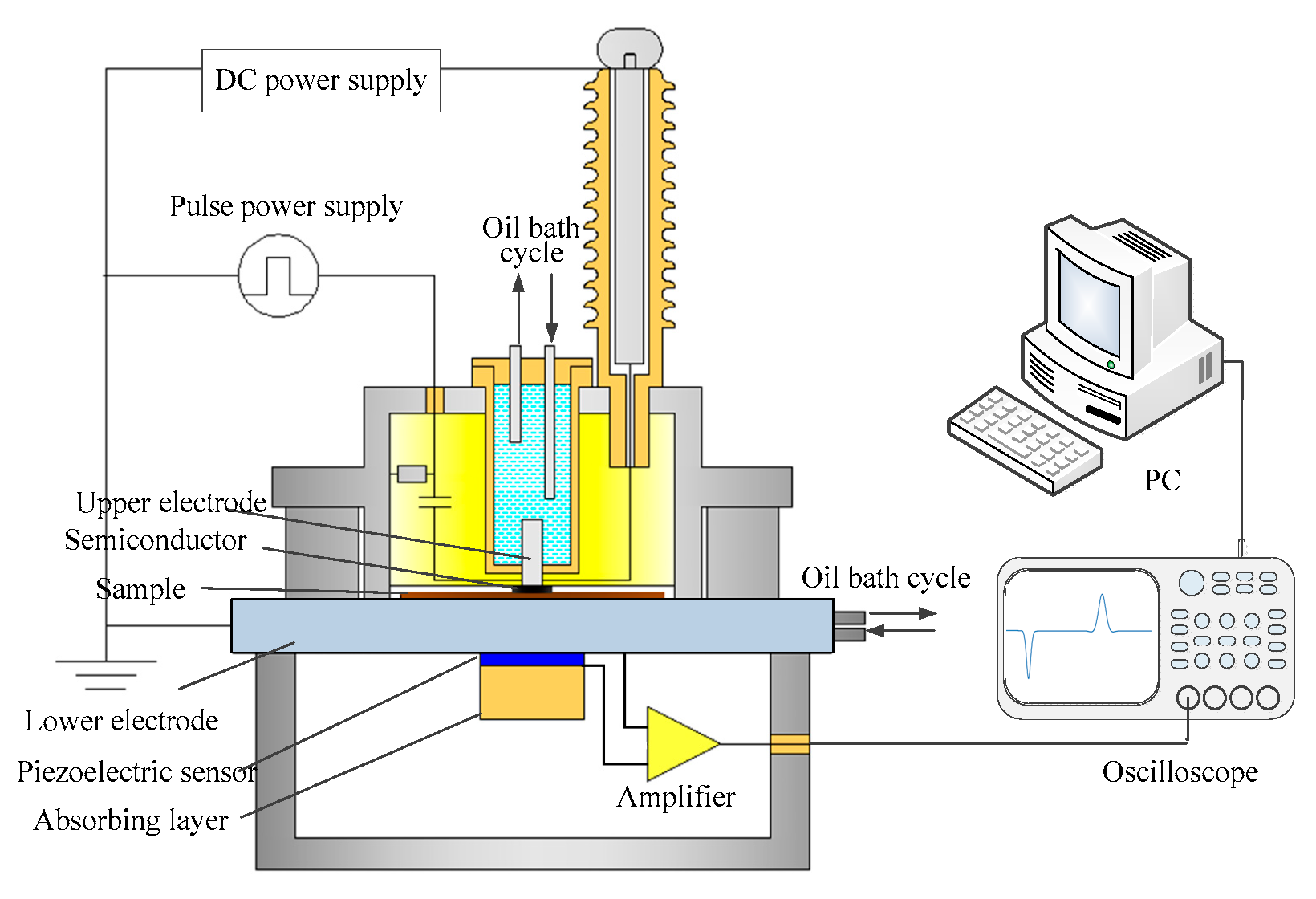
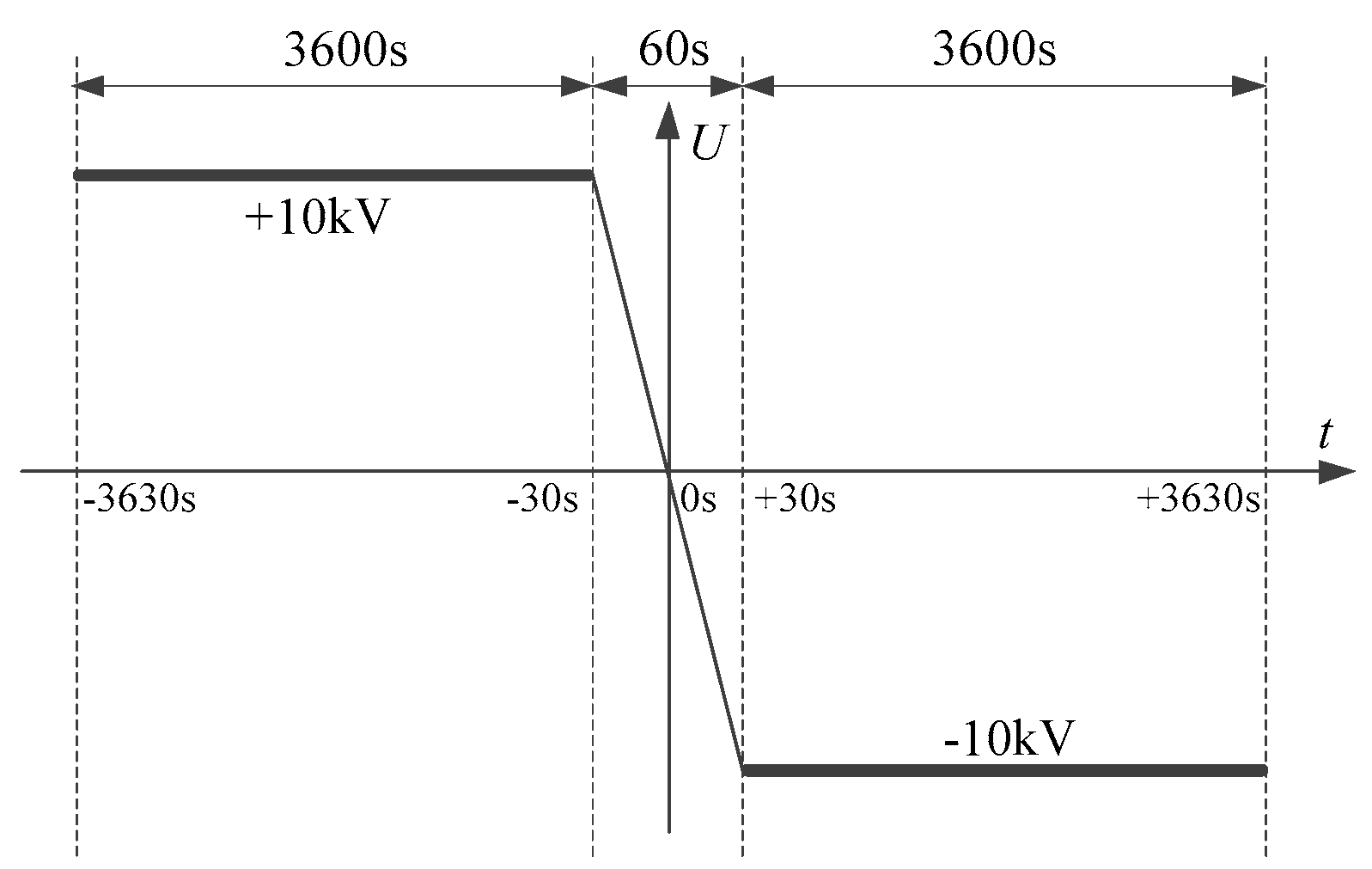



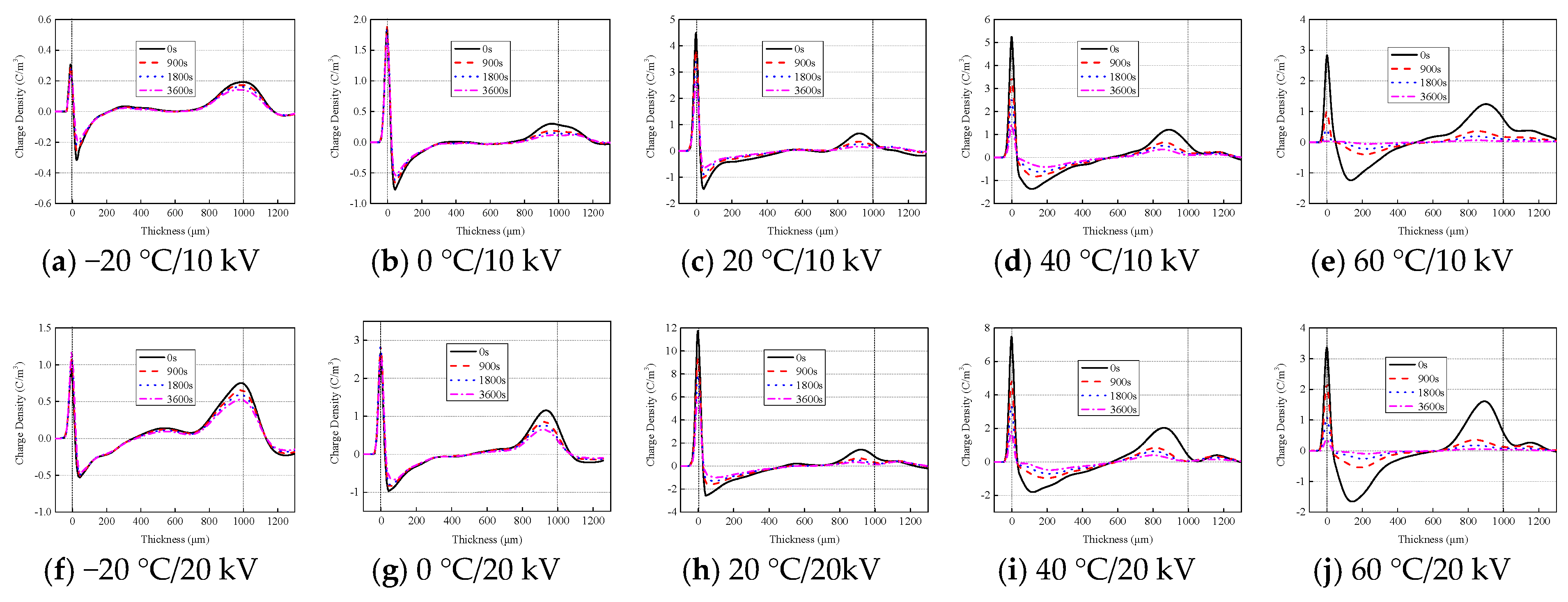

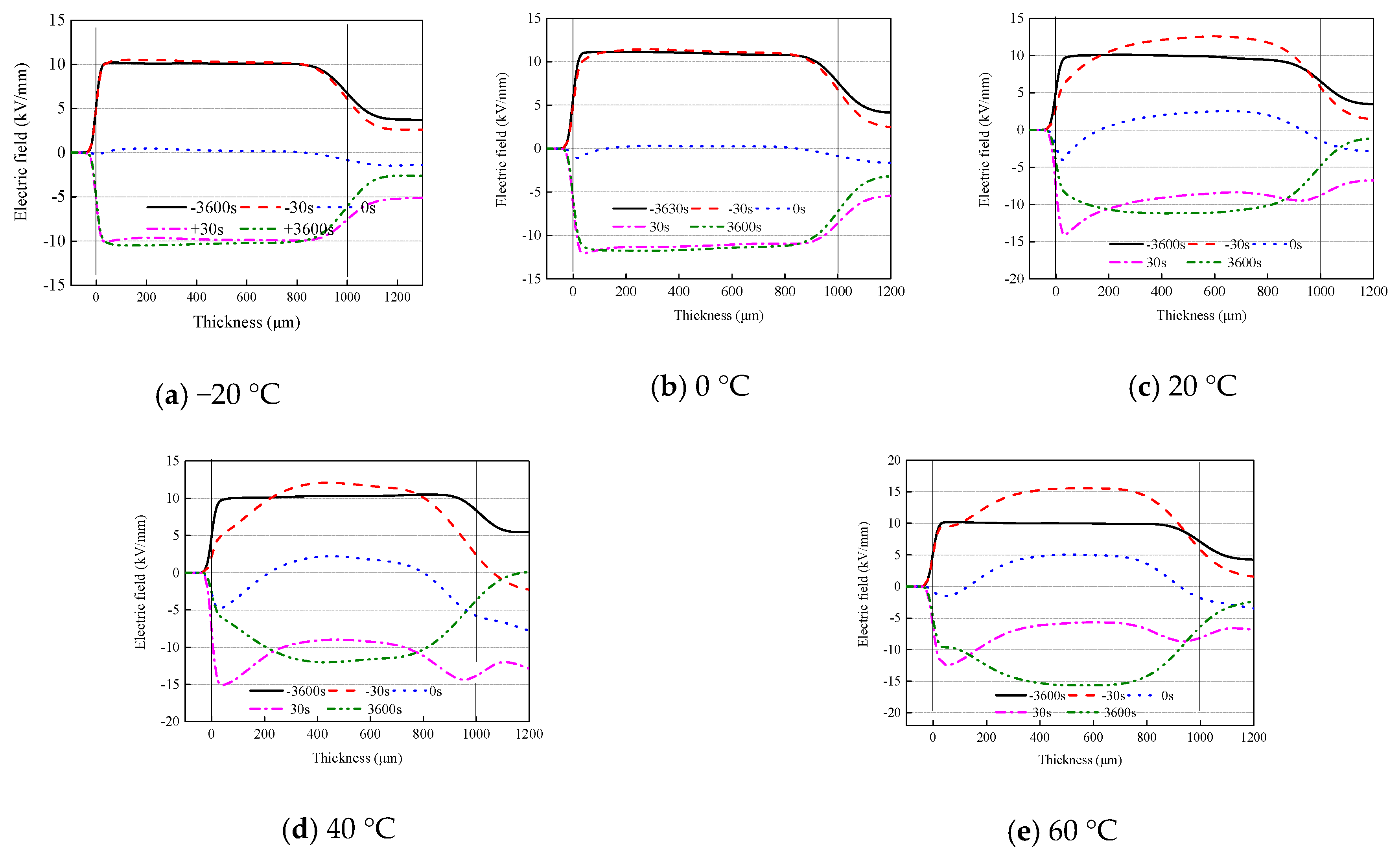


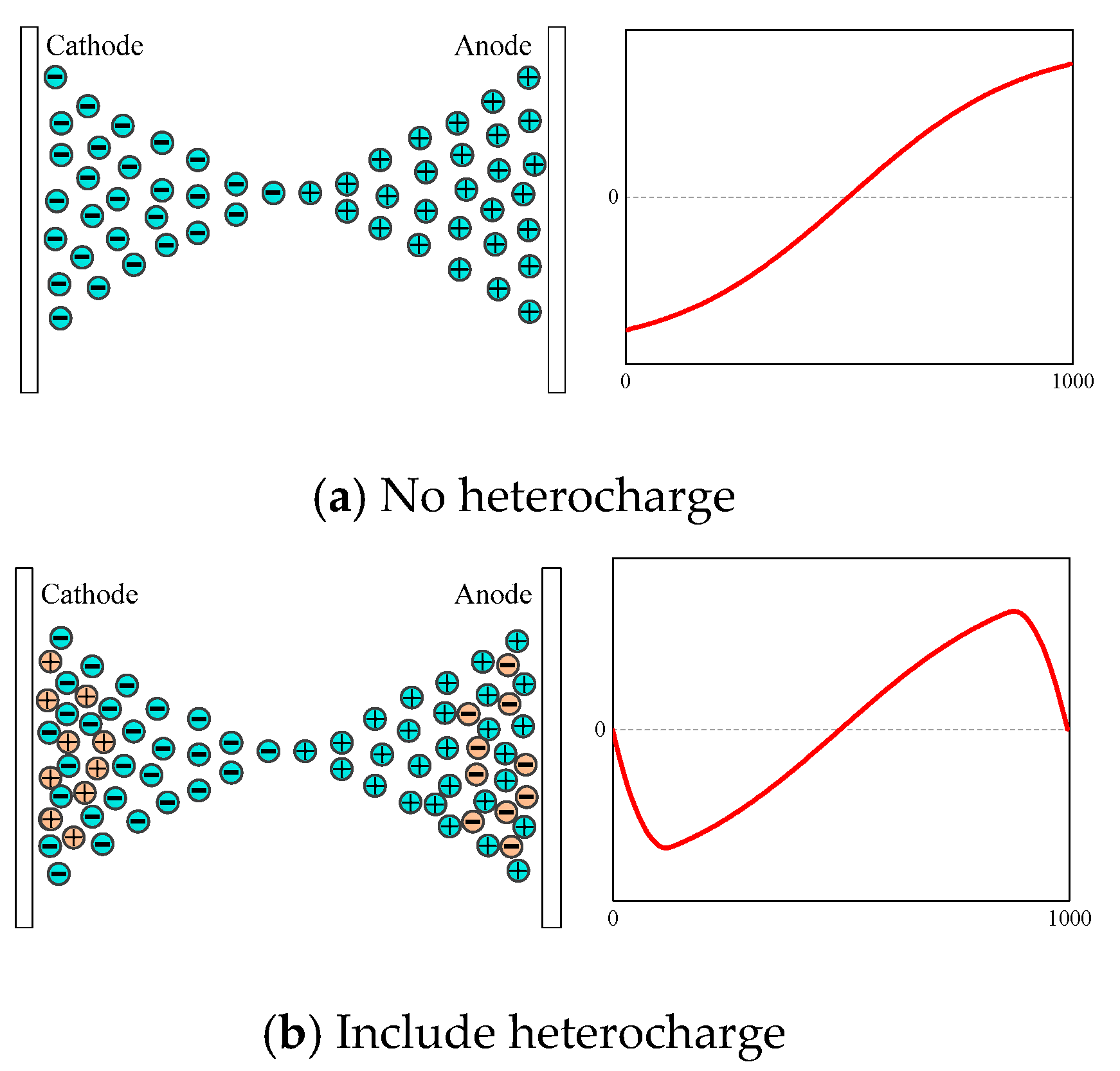

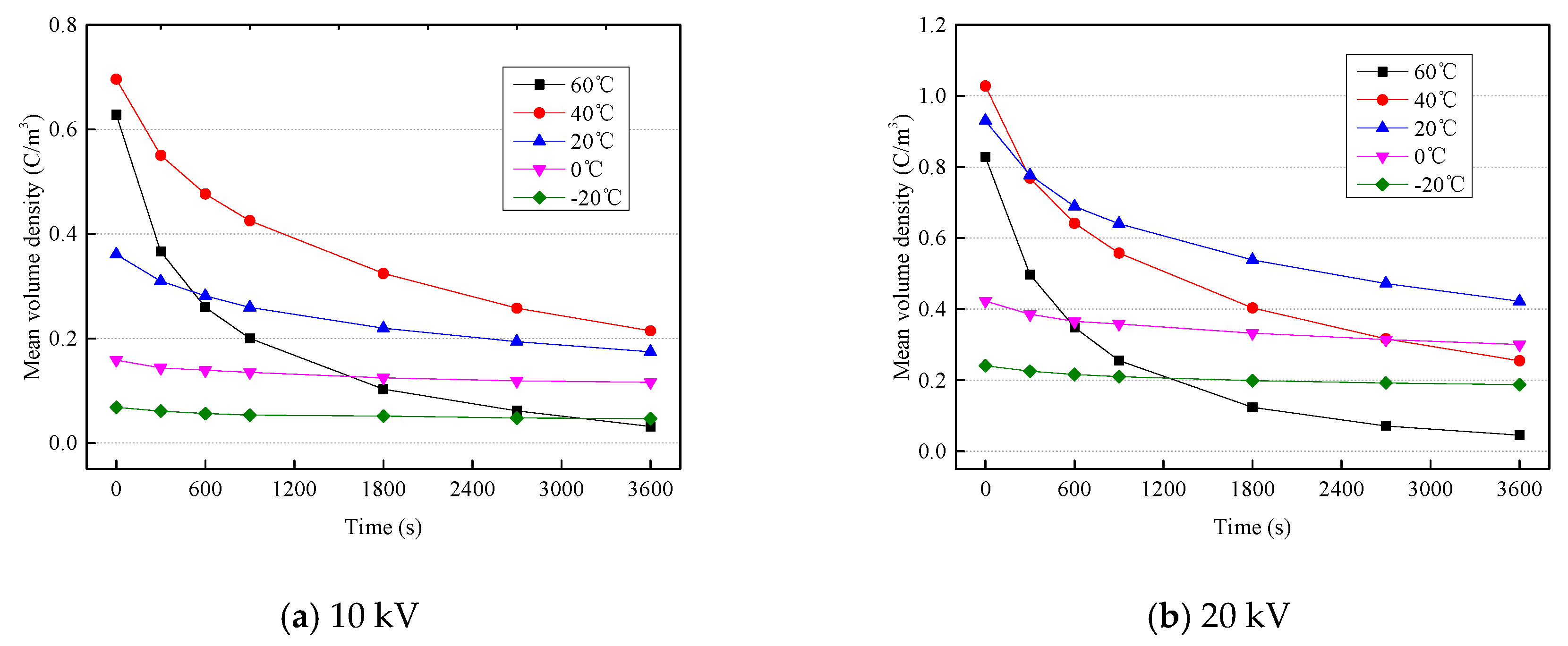
| Parameters | Transformer Oil | Pressboard |
|---|---|---|
| moisture content | 6.3 mg/kg | 0.43% |
| resistivity | 1.15 × 1013 Ω·m | 4.93 × 1014 Ω·m |
| relative permittivity | 2.08 | 4.3 |
| Temperature | Electric Field (kV/mm) | Charge Density (C/mm3) | ||||
|---|---|---|---|---|---|---|
| −30 s | 0 s | 30 s | −30 s | 0 s | 30 s | |
| −20 °C | 10.17 | 0.09 | −10.05 | −9.87 | 0.34 | 10.51 |
| 0 °C | 9.17 | −1.06 | −11.39 | −9.17 | 1.28 | 11.71 |
| 20 °C | 6.63 | −4.02 | −14.04 | −5.55 | 4.19 | 14.50 |
| 40 °C | 4.10 | −5.95 | −15.52 | −3.79 | 7.90 | 17.36 |
| 60 °C | 9.51 | −1.49 | −12.43 | −10.15 | 1.44 | 12.88 |
© 2018 by the authors. Licensee MDPI, Basel, Switzerland. This article is an open access article distributed under the terms and conditions of the Creative Commons Attribution (CC BY) license (http://creativecommons.org/licenses/by/4.0/).
Share and Cite
Chen, Q.; Zhang, J.; Chi, M.; Tan, P.; Sun, W. Effect of Temperature on Space Charge Distribution of Oil–Paper Insulation under DC and Polarity Reversal Voltage. Energies 2018, 11, 2271. https://doi.org/10.3390/en11092271
Chen Q, Zhang J, Chi M, Tan P, Sun W. Effect of Temperature on Space Charge Distribution of Oil–Paper Insulation under DC and Polarity Reversal Voltage. Energies. 2018; 11(9):2271. https://doi.org/10.3390/en11092271
Chicago/Turabian StyleChen, Qingguo, Jinfeng Zhang, Minghe Chi, Peng Tan, and Wenxin Sun. 2018. "Effect of Temperature on Space Charge Distribution of Oil–Paper Insulation under DC and Polarity Reversal Voltage" Energies 11, no. 9: 2271. https://doi.org/10.3390/en11092271




